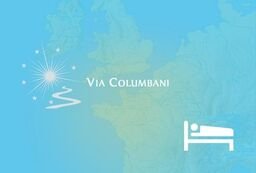Trier to Leiwen

Rheinland-Pfalz
3. Trier to Leiwen
Difficult
7h30
30,6km
+872m
-878m
Step
Embed this item to access it offline
Leaving Trier you will cross a hill to avoid a loop of the Moselle, then you will follow the banks of the river before crossing another wine-growing hill to reach Leiwen .
8 points of interest
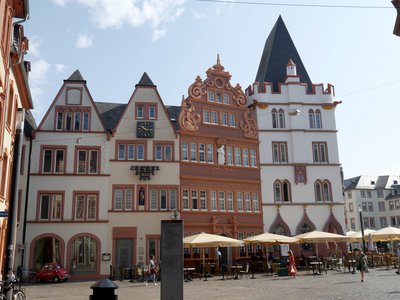
Maisons avec des façades baroques, place du Marché - Les Amis de saint Colomban HistoricalThe Old Town of Trier
The Hauptmarkt in Trier with its squares and baroque houses is still a lively district. Stroll through its streets and discover Trier's heritage.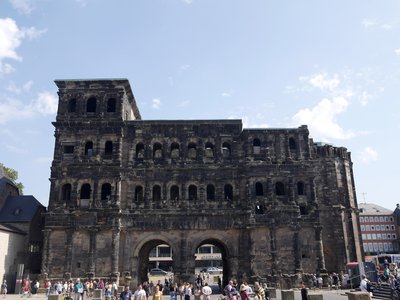
Porta Nigra à Trèves - Amis de saint Colomban HistoricalPorta Nigra in Trier
The Porta Nigra ("Black Gate" in Latin) is a 2nd century fortified building which controlled access to the city of Trier from the north. This gate is built of sandstone blocks that are assembled without cement. A landmark of the city of Trier, it is one of the oldest fortified city gates in Germany.
The Greek monk Simeon came to live in the monument as a hermit around the year 1028 and was probably cloistered there. After his death in 1035, he was brought back down to the ground floor and canonized. A sanctuary was built in his honour and the Porta Nigra was used as a two-storey church, the apse of which can still be seen on the eastern side of the monument.
In 1802 Napoleon Bonaparte ordered the destruction of the church. During his visit to Trier in 1804 he gave the order to restore the Porta Nigra to its original Roman configuration, including the destruction of all surrounding buildings and the restoration of the inner courtyard and the original level of the ancient ground.
Strangely enough, however, the restoration will preserve the lower part of the apse of the church and the east tower will not be rebuilt to its ancient height. The Porta Nigra thus cleared and restored remains asymmetrical and today offers a composite appearance that is not fully in keeping with its ancient appearance.
More information: Wikipedia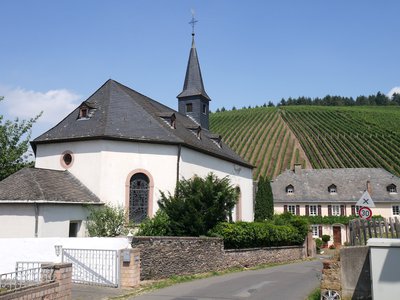
La chapelle des 14 Saints à Eitelsbach avec le vignoble. - Les Amis de saint Colomban TouristDie 14 Nothelfer Kapelle in Eitelsbach
In 1755 a small chapel, dedicated to the 14 Saints of Mutual Aid, was built by the Abbey of Saint-Michel de Maximin. Except for Sunday morning mass, celebrated in the chapel, the people of Eitelsbach had to go to the church in Ruwer.
Great natural disasters led to the destruction of the chapel at the beginning of the 19th century. In 1848 the new chapel was rebuilt. In spite of the greater poverty of the Eitelsbach parishioners, they built this beautiful little chapel which still exists today and which was completely renovated only a few years ago.
The chapel is closed.
The 14 Saints of Relief or Mutual Aid
The Fourteen Holy Assistants are fourteen saints from the second to the fourth centuries. According to Regensburg's so-called normal series, the group consists of three saints and eleven male saints, all of whom died as martyrs with the exception of the martyr Aegidius . There are regional variations. In the Catholic Church, first-aid workers are called as patrons in prayer. In the Evangelical Church, they are generally regarded as models of faith.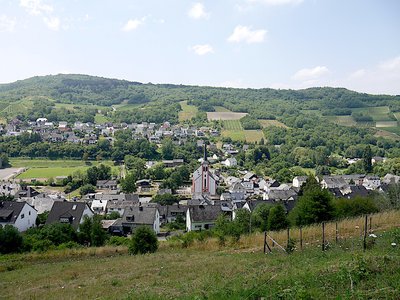
Vue de l’église de Fell depuis la Via Columbani - Les Amis de saint Colomban TouristSt. Martin's Church in Fell
A stone inscription found in the present church tower tells of the construction of a choir in 1431, and the parish church of that time was at right angles to the present one. The present parish church was built between 1865 and 1868 in neo-Gothic style according to the plans of the Luxembourg state architect Carl Arendt. It was dedicated to the patron saints of the "old church", St Martin and St Barbara, the patron saint of the miners of Fell. An extensive renovation took place in 1970/1971, including the addition of the present sacristy. During a renovation in 1993/1998, which again became necessary, the roof of the church was covered, the windows were replaced, taking into account the old patterns, and the interior and exterior painting was completely renewed. Three bells hang in the tower of the parish church: the bell of the war memorial "regina pacio", the bell of Martinus from 1579 and the bells of Sebastian and Barbara.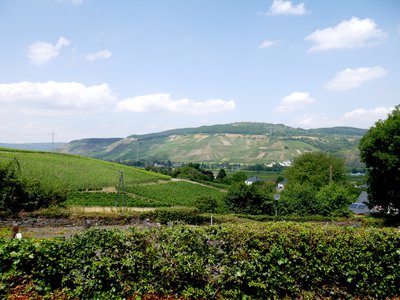
La vallée de la Moselle vue depuis l’église de Riol - Les Amis de saint Colomban TouristThe wine village of Riol
In 70 A.D. a Roman colony was founded in Riol on the road from Trier to Koblenz.
The name Riol indicates a Celtic origin. Situated on the Roman road from Trier to Mainz, there were already many villas and farms in Roman times. Peter von Aspelt, the "kingmaker", was pastor here before he became archbishop of Mainz and thus arch-chancellor.
A large number of restored old farmsteads, fountains and nostalgic streets under the picturesque St. Martin's Church with its Romanesque tower (inside of the church in rococo style), which is also based on a Roman foundation, invite you to linger.
An important leisure centre has been built on the banks of the Moselle.
The wine from the "Rioler Römerberg" vineyard prompts the town to open the annual wine festival round along the Roman Wine Route at the end of May each year.
Further information: Mosel.de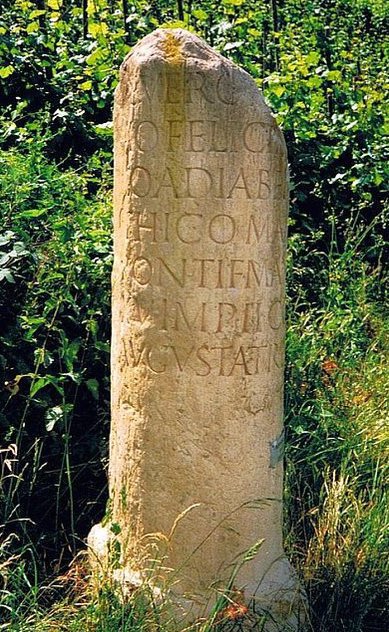
Borne de Caracalla - Amis saint Colomban HistoricalMillarium (Roman military post) of Caracalla
Located on the Via Columbani on the Moselle opposite the town of Pölich, this landmark will tell you its history.
In ancient Rome, milestones (in Latin miliaria1 in plural, Miliarium in sing.) were stone road markers, usually in the form of a column bearing an inscription and intended to mark the distances along the main Roman roads in Italy and the Roman provinces. As their name suggests, distances were measured in Roman miles, or about 1,480 metres.
Antonine's Itineraries were divided into provinces that are attributed to the Severian Emperor Anthony (Caracalla, the Soldier's Boot).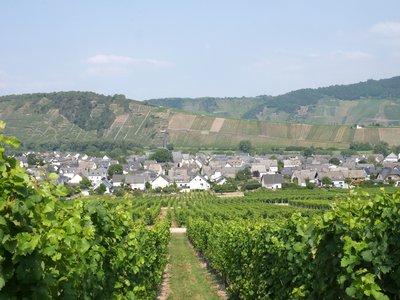
Vue générale de Liewen enveloppée dans son vignoble - Les Amis de saint Colomban PanoramicVineyards in Leiwen
Leiwen is characterized by wine-growing and with 273 hectares of vines planted after Piesport and Zell, the largest wine-growing community in the Moselle. It is traditionally cultivated mainly with Riesling. The proportion of white grapes is 94.2%. There was a turning point in Leiwen's viticulture in 1985 thanks to the newly founded association "Leiwener Jungwinzer". The successful concept was to move from mass production to lower yields, careful harvesting and careful treatment of the wine in the cellar. The competition of definition samples remains the most important step in the optimization of quality.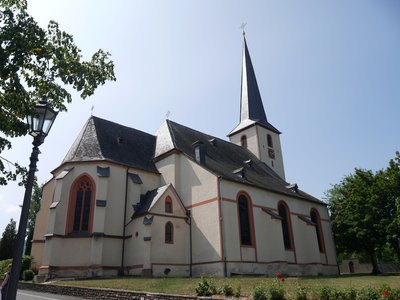
Église Saint-Étienne à Leiwen - Les Amis de saint Colomban TouristSt. Stephen's Church in Liewen
The foundations date from the 15th century, the nave and the bell tower were rebuilt in the 19th century in a Baroque style. The furniture is in rococo style. In 1920 two aisles were added.
During the works in 1982 frescoes were discovered and saved.
In the crypt, vestiges of 16th century Gothic painting can still be seen.
Description
Departure from Trier Cathedral cross the Domfreihof, right Simeonstrasse cross Christophstrasse and Porta-Nigra-Platz, continue on Paulinstasβe.
- Third street on the right on Wasserwerg, pass under the railway, Avelsbacher Str.
- At the fire station turn left into Am Grünenberg and then Ruwerer Straβe.
- Auf Palinsgarten (K15) then follow Auf Schwarzfeld.
- Turn right at the chapel der 14 Nothelfer and follow "Merterdorfers Straβe (K15), Eitelsbacherweg, right at the crossroads with Hauptsstrasse (K77) out of town
- Pass under L 151, turn right on to a path between meadows and up a winding path down to Fell, Ruwerer Straβe
- Turn left onto Bachstrasse after the brook Kirchstrasse (L 150), second street on the right Zur Acht, leave Zur Acht at the rescue station and go straight up the path to the Vogtel summit, go down into the forest to pass under the A1.
- Left at the crossroads in the vineyard direction Riol, Bergstrasse, right Haupstrasse, fork Moselstrasse
- In front of La Moselle on the right hand side take the Moselle river banks, Continue on the right bank for 6 200 meters.
- After the marina on the left bank, turn right into the vineyard and follow the edge of the wood, second vineyard path on the left, straight up to go around the hillside while remaining in the vines.
- Turn right into "Muhlenstrasse" at the roundabout straight ahead Mulhenstrasse, second street on the right Stefanusstrasse, on the left Kirchstrasse you reach the church St. Stephanus.
- Departure : Cathedral St. Peter, Liebfrauenstraße 12, 54290, Trier
- Arrival : St. Stephanus Church, Kirchgasse 8, 54340 Leiwen
- Towns crossed : Rheinland-Pfalz
Altimetric profile
Report a problem or an error
If you have found an error on this page or if you have noticed any problems during your hike, please report them to us here:




